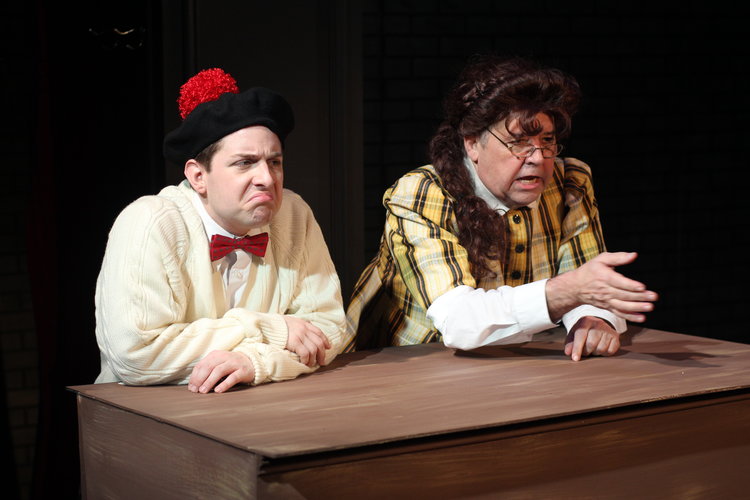Review of The 39 Steps, Music Theatre of Connecticut
Enter the wacky world of spies in England and Scotland between the two great wars of last century. Adapted by Patrick Barlow for the stage, from John Buchan’s 1915 novel by way of Alfred Hitchcock’s 1935 thriller, The 39 Steps, directed by Pamela Hill at Music Theatre of Connecticut, keeps up a steady pace of escapes and oddball encounters, with the tone of an espionage story jettisoned in favor of skit comedy and slapstick. With all characters played by four actors, and the artifice of theater exposed right on the stage, props get put through their paces and the audience is made to indulge its imagination.
Richard Hannay (Gary Lindemann), Annabella Schmidt (Laura Cable) (photos from Music Theatre of Connecticut)
MTC likes such stripped down staging, as it has shown with its staged radio shows, and much of the charm of the show comes from a willingness to make theater a frenetic game of make-believe. That starts with Gary Lindemann’s Richard Hanny, a posh Brit who lounges about narrating his ennui before being catapulted into a series of dangerous predicaments by way of an encounter with Annabella Schmidt, a mysterious German woman played with hilarious creepiness by Laura Cable. Lindemann’s Hanny is a kind of unflappable Everyman, even if there’s nothing at all everyday about his adventures.
Pamela (Laura Cable), Richard Hannay (Gary Lindemann)
The acting here is turned up a few notches from the kind of overplaying you’d find—played for real—in B movies, or on radio programs. The situations also smack of radio shows, with visualization a key part of the effect—except, of course, for the sight gags. My favorite features Lindemann and Cable—as Pamela, a skeptical woman pressed into aiding Hannay—handcuffed together and trying to get over a stile. And the bit when she removed her stockings while handcuffed makes comedy of discomfort.
Clown #2 (Matt Densky), Clown #1 (Jim Schilling)
The play is designed to let such tomfoolery go on as long as it can, particularly the many bits furnished by the two clowns, Matt Densky and Jim Schilling. It helps that Schilling bears a resemblance to that great veteran of televised skit comedy, Tim Conway. When Schilling mutters and putters around, setting up chairs for a speech, or has to carry several chairs offstage at once, the gags are vintage Conway. As the other Clown, Matt Densky tends to specialize in outrageous voices—I don’t think I’ll ever forget how his diabolical German says “Mr. Hannay!”
Clown #2 (Matt Densky)
The presence of diabolical Germans and slow-witted Scots (without quite as funny an accent as you’d expect) and bland society types and traveling lingerie salesmen, to say nothing of the many caps Schilling juggles as cop, train conductor, and passenger, lets us experience a parade of characters as matters of costume and voice and mannerism.
The cast of The 39 Steps
The entire cast is having so much fun you might find yourself forgetting what is going on with the story. It doesn’t really matter, and the plot’s flights of fancy are abetted by a number of references to Hitchcock films for the attentive. I have to say though that the production I saw in London’s West End in 2015 seemed more verbally inventive, but that might be the effect of familiarity.
MTC’s version of this screwball caper comedy brings together two of its top comic actors—Schilling, who has played many roles, and Densky, last seen as the irritable department store elf in The Santaland Diaries—with Lindemann and Cable, two other comic talents who work very well together, to provide an evening of inspired silliness with pretty much a gag a minute. Seeing these quick-timed switches in such close proximity to an audience makes for a certain awe at what they get away with.
The 39 Steps
Adapted by Patrick Barlow
From the novel by John Buchan
From the movie by Alfred Hitchcock
Directed by Pamela Hill
Costume Design: Diane Vanderkroef; Wigs: Peggy de la Cruz; Set Design: Jordan Janota; Lighting Design: Michael Blagys; Sound Design: Monet Fleming; Stage Manager: Gary Betsworth
Cast: Laura Cable, Matt Densky, Gary Lindemann, Jim Schilling
Music Theatre of Connecticut
March 2-18, 2018







